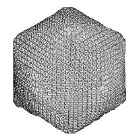Plant Pathology, Department of

James Van Etten Publications
Document Type
Article
Date of this Version
8-2014
Citation
Journal of Virology, November 2014, Volume 88, Number 21, pp. 12541–12550.
Abstract
Superoxide dismutases (SODs) are metalloproteins that protect organisms from toxic reactive oxygen species by catalyzing the conversion of superoxide anion to hydrogen peroxide and molecular oxygen. Chlorovirus PBCV-1 encodes a 187-amino-acid protein that resembles a Cu-Zn SOD with all of the conserved amino acid residues for binding copper and zinc (named cvSOD). cvSOD has an internal Met that results in a 165-amino-acid protein (named tcvSOD). Both cvSOD and tcvSOD recombinant proteins inhibited nitroblue tetrazolium reduction of superoxide anion generated in a xanthine-xanthine oxidase system in solution. tcvSOD was chosen for further characterization because it was easier to produce. Recombinant tcvSOD also inhibited a riboflavin photochemical reduction system in a polyacrylamide gel assay, which was blocked by the Cu-Zn SOD inhibitor cyanide but not by azide, which inhibits Fe and Mn SODs. A kcat/Km value for cvSOD was determined by stop-flow spectrophotometry as 1.28 X 108 M-1 S-1, suggesting that cvSOD-catalyzed O2- dismutation was not a diffusion controlled encounter. The cvsod gene was expressed as a late gene, and cvSOD activity was detected in purified virions. Superoxide accumulated rapidly during virus infection, and circumstantial evidence indicates that cvSOD aids its decomposition to benefit virus replication. Cu-Zn SOD homologs have been described to occur in 3 other families of large DNA viruses, poxviruses, baculoviruses, and mimiviruses, which group as a clade. Interestingly, cvSOD does not group in the same clade as the other virus SODs but instead groups in an expanded clade that includes Cu-Zn SODs from many cellular organisms.


Comments
Copyright © 2014, American Society for Microbiology. All Rights Reserved. Used by permission.